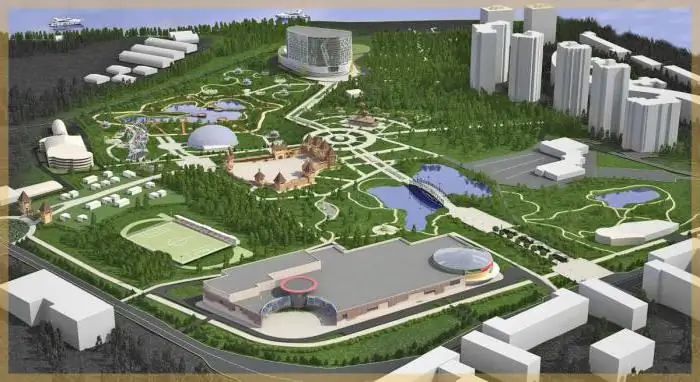- Author Harold Hamphrey [email protected].
- Public 2023-12-17 10:06.
- Last modified 2025-01-24 11:10.
Goloseevsky district of Kyiv is one of the most densely populated. It is located in the southwest of the Ukrainian capital. The area of the district is about 150 km2, and the number of residents exceeds 200 thousand people.

Where did the name come from?
Historians and philologists have not yet come to a consensus on what the name Goloseevo means. Some believe that it came from the crying of people who were driven into Tatar captivity. Others believe that the reason for the name is the name of the first owner.
But the most likely assumption is that forests were planted on these empty and bare places at one time. Now Goloseevsky district is considered the "lungs" of the capital. At one time it was famous for its oak forests, and the age of the trees reached 600 years.
History of the area
The first mention of Goloseevo can be found in the annals of the 16th century. First, these were lands that belonged to the Kiev-Pechersk Lavra, and then to the monastery. In the 18th century, a park was laid on a large square, and the area gradually turned into a summer cottage.
When in the middle of the 19th century factories, factories appeared in the Goloseevsky district, a railway was laid onMoscow, the area is being actively built up with residential buildings and populated.
The invaders who came to Ukrainian lands during the Civil War cut down and removed a significant part of forest plantations, especially old oaks.
In 1921, the administrative division of Kyiv into districts takes place. The historical villages of Kitayevo, Myshelovka, Feofaniya, Demievka, Pirogovo, Vodnikov Island, Teremki and others depart from Goloseevsky.
Transport network
The main transport artery of the district is Velyka Vasylkivska. In total, there are about 300 streets and alleys on the map of the district.

Goloseevsky district, according to residents, is conveniently connected by the metro network with the central part of Kyiv. The following stations are located in the area:
- 9 stops of the "Kurenevsko-Krasnoarmeyskaya" line, starting from the station. m. "L. Tolstoy Square" to the station. m. "Teremki".
- "Vydubychi" - a stop on the "Syretsko-Pecherskaya" line.
You can get to the subway by public transport. 4 streets lead to the center:
- Goloseevsky prospect;
- Capital Highway;
- Dniprovskoe highway;
- partial Valery Lobanovsky Avenue.
There is a network of railway stations in the area, included in the Kiev-Moscow direction. From the metropolitan area Goloseevo you can go to other Ukrainian cities from the Central bus station and bus stations "Vydubychi" and "Yuzhnaya".
Streets of Goloseevsky district
In honor ofof the ancient district of Goloseevo, not only one of the main avenues was named, but also a square and a lane.
The streets of the Goloseevsky district bear the names of writers, poets, scientists and artists. For example, Levitan, Kvitka-Osnovyanenko, Tsiolkovsky, Stelmakh, Tolstoy, Gaidar, Zhukovsky.
There are streets with geographical names: Pyatigorskaya, Feodosiyskaya, Sumy, Zakarpatskaya, Pskovskaya, Odesskaya and others.

Infrastructure
Goloseevsky district of the capital is considered one of the most planted. The air here is fresh all year round. A significant part of the territory is occupied by green spaces.
- Natural National Goloseevsky Park. In terms of area, this is one of the largest park areas in Europe - more than 140 hectares. Some trees are 200-400 years old. The charm and beauty of the park are given by natural lakes scattered throughout the area, flowing into each other, and artificial ponds.
- Partly Goloseevsky array occupies the park named after. M. Rylsky, where the museum of this famous Ukrainian poet is located. There are also attractions, boat stations, sports grounds.
- Feofaniya Park surrounds one of the largest medical centers in the country. On its territory there are springs with healing water.
- Koncha-Zaspa - a place of elite recreation.
- VDNKh Park with bike paths and places for walking with children.
- Pirogovo Park, where the museum of architecture of the Ukrainian people is located.
The quiet territory of the Goloseevsky district has become a place where science flourishes. In thispart of the city there are 2 universities: bioresurs and agrarian, as well as an observatory and an exhibition center.
Goloseevsky district in the photo looks not only green, but also very lively. In recent years, this Kyiv region has been actively built up. 2 microdistricts called Teremki have grown here. All conditions for life and recreation have been created for residents: sports, art and general education schools are open, there are sports grounds, playgrounds, shops, shopping centers.
Only in Goloseevo there is a city hippodrome, as well as bases for training figure skaters on ice and football players.
The economy of the district is based on the activities of almost 60 industrial enterprises.

Sights of Goloseevsky district
Although the Goloseevsky district is not considered a place attractive for tourists, there are many interesting places here. Thus, there are several museums dedicated to the work of Ukrainian writers. The territory of Baikove Cemetery is interesting for inspection, where crypts in Lutheran, Catholic and Orthodox styles have been preserved. You can spend the whole day in the Pirogovo Museum, visiting Ukrainian houses, mills, workshops, preserved from the 17th century.






